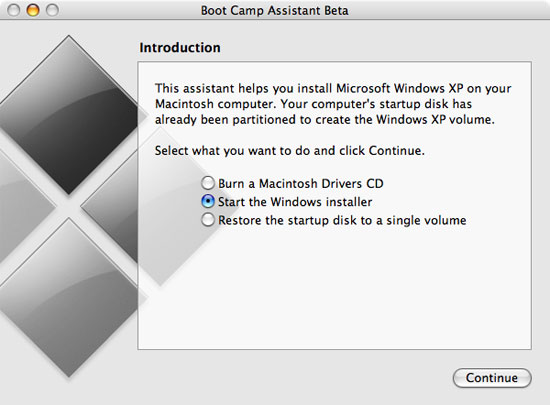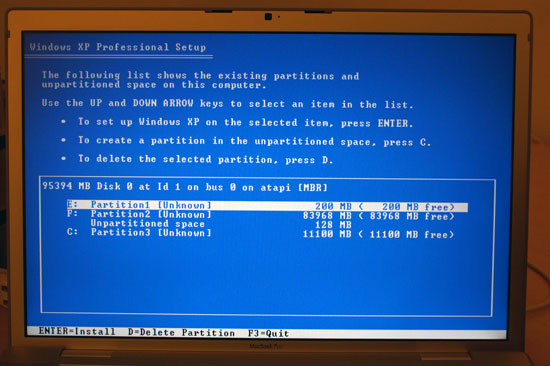Apple's MacBook Pro: Using it as a Mac and a PC
by Anand Lal Shimpi on April 13, 2006 12:00 AM EST- Posted in
- Mac
Apple's Military Aspirations
The slightly redesigned exterior, integrated iSight and performance improvements are more than enough to make the MacBook Pro stand on its own. It's rare that you can make a single upgrade and experience such a noticeable increase in performance, but as I mentioned at the beginning of this article, the MacBook Pro has a couple of features that make it even more enticing.

Apple released the first public beta of Boot Camp, an application that allows you to install Windows XP SP2 on your Intel based Mac. Apple announced that Boot Camp would be shipping with the next version of Mac OS X (10.5), codename Leopard, but until then we've got this free public beta.
The Boot Camp setup process is extremely straightforward, and a lot easier than even I expected it to be. After mounting the Boot Camp image and running the installer I was told that I needed to update my firmware before proceeding with the installation. Given that my MacBook Pro was an earlier revision (Rev C) it didn't have the updated firmware so I had to download and install it before proceeding.
Interestingly enough, the process is different on the MacBook Pro than upgrading firmware was on my PowerBook G4 and PowerMac G5; those two machines simply updated their firmware through OS X's Software Update utility, whereas the MacBook Pro requires you to go out and download the firmware update on your own. I'm not sure if this is because of the switch to Intel or something else entirely.
The firmware update gives you very little feedback or information as to what's going on: you run the program and it shuts down your MacBook Pro. You are then told to hold down the power button until the front power LED starts flashing. Once the front LED starts flashing the firmware update begins and you'll see a grey screen with a progress bar at the bottom of it. When it's done you're greeted with a ridiculously loud beep and then the system reboots and works as normal.

With the firmware updated I ran the Boot Camp assistant once more and now I was ready to begin. The assistant prompted me for a blank CD so it can burn all the drivers I'd need onto that disc. Unfortunately it's impossible for you to get the Boot Camp assistant to run on a non-Intel Mac so your only hope for creating the driver disc is on your MacBook Pro or if you have another Intel based Mac laying around.

After burning the driver CD it's time to start the actual installation process. Boot Camp comes with its own partitioning utility, and it requires a minimum of 6GB set aside for your Windows partition; I chose 10, but you can select whatever you'd like. If you actually plan on using the Windows partition on a regular basis for applications and games you may want to make it even larger (as well as opt for the larger 120GB drive). The repartitioning is non-destructive so your OS X installation, applications and documents are safe. Amazingly enough, the repartitioning only took about 2 minutes.

With the partition created and my Windows XP SP2 disc in the drive, it was time to reboot and start the installation. The Boot Camp assistant warns that you must have a Windows XP SP2 disc (either Home or Professional), a SP1 disc will not work. If all you've got is a SP1 disc then you'll have to create a slipstreamed version with SP2 yourself.
After the reboot I was dropped into the very familiar Windows XP setup process, which from this point on behaved entirely as normal. The only thing to pay attention to here is that you want to make sure you format and install to the right partition, as they aren't labeled. I selected the 10GB partition I had created earlier and chose to format it as a FAT partition (Windows setup forced FAT32 because of the size of the partition, although listing FAT). The benefit to using a FAT32 partition is that the partition will be read and write accessible from within OS X; if you create a NTFS partition you'll only be able to read from it in OS X, you won't be able to write to it.

With the partition formatted (a quick format works just fine), the rest of the Windows install proceeded as normal. All reboots went directly into Windows setup and I hardly remembered that I was doing all of this on a Mac.










52 Comments
View All Comments
nels0360 - Thursday, April 13, 2006 - link
The hardware issue mentioned have been or are being fixed.Apple has release silent revisions of the MacBook Pro. It is well documented on other sites such as Macrumors.com
In fact, I believe Apple will give you a new revision if you complain about one of these problems.
plinden - Thursday, April 13, 2006 - link
I know they are different benchmarks, but over at http://www.macworld.com/2006/04/firstlooks/xpbench...">MacWorld, they found that the MacBook Pro was faster at running Windows than three Windows-only PCs.I'm not going to editorialize here, just bringing this to your attention.
ss284 - Friday, April 14, 2006 - link
Which pretty much drops macworld's benchmark credibility to zero. Actually, their credibility was already really low so its no big deal.ss284 - Friday, April 14, 2006 - link
Unless the benchmark was how fast it could burn a hole in your pants and sterilize your important parts.jbb132 - Thursday, April 13, 2006 - link
Sadly, even the most recent MacBook Pro's continue to suffer from the hardware problems you noticed. I've now had two units with the "whine," particularly when the laptop is running on battery power. The only way to stop it is to turn photobooth on and leave it on. Various hacks (magicnoisekiller in particular) help but really...Pirks - Thursday, April 13, 2006 - link
Hey Anand!Thanks for an interesting review! Now, what was the video source codec and resolution in your H.264 encoding test? I've got a Mac zealot here saying he's got only 2 frames per second in similar H.264 encoding task. He also has Mac OS X 10.4.6 and Quicktime Pro 7.0.4. I wonder is you used source with resolution like 160 by 120 for that test??
To other readers: take with a grain of salt Anand's view on running multiple apps simultaneously in XP. He says something like "uh oh we can't run multiple apps all the time on win coz win can't manage its RAM blah blah", but in fact if you disable XP swap AND if you stick 2 or 3 gigs or RAM in your mobo you'll get my experience of running dozens of apps open at the same time and even some games while at it (DOOM 3 + Matlab + Maya 7 + other little apps like VDub open at the same time is a no brainer on my XP). Stick 4 gigs and open even more, without loss of performance. In fact if you wanna get Mac OS X experience, just stuff your mobo with RAM and turn off swap, that's it, no need to spend $$$ on Mac to get this "experience" :-))
One last minor correction - Anand tells you "anything more than 2GB of RAM on your PC is useless" but he does not know about /3GB switch (google up "/3GB switch") which again allowed me to run Matlab with THREE gigs or RAM consumed, not two.
Just my 2 cents to debunk some myths that Mac zealots love to spread ;) Don't get caught in that stuff, read docs/mans and be smart.
Anand Lal Shimpi - Friday, April 14, 2006 - link
The source for my H.264 test was the Hoodwinked trailer from Apple's Quicktime trailers site.My comments about memory usage and Windows XP have nothing to do with the /3GB switch. The point I was trying to make is that Windows XP does not do a good job of caching to reduce disk accesses. Microsoft itself has admitted that there's lots of room for improvement, which is why you hear about all of the caching improvements that will be introduced in Vista.
Take care,
Anand
kleinwl - Thursday, April 13, 2006 - link
BTW: if you don't think that anandtech knows about the /3GB switch you certainly haven't been here very long.Pirks - Thursday, April 13, 2006 - link
Did Anand ever mention this switch in any of his reviews? Or anyone else besides him from AT staff? I've never seen it before. How about you? Would you provide me with a link or some other proof? I'd love to be corrected here, since AT guys should know about it, and I wish I were wrong stating the opposite, especially about Anand himself.As for the stability - I run Matlab with 3GB consumed routinely, it also loads some Maya 7 stuff internally via my own DLL and there's another Maya 7 hanging around to check results from Matlab quickly, and I never saw a slightest glitch. Of course YMMV but I heard too much "omg windoze is 2GB limited and mac is TrUe 64-bit WoNdEr" and I've got some experience with Matlab on both Mac OS X (no 64-bit matlab there) and WinXP (now this is true 64-bit product) to let Anand repeat that kind of sh.t. Mac guys are ok to say that, they live like this, so no big deal but not Anand please :-) So let's just say "please Anand be a bit more correct in some places and don't sound like a dumb Mac user", saying windows can't properly run a lot of apps at once and stuff like that.
Speaking of Vista I've read somewhere on MSDN that a lot of XP 64 code is in there so it _should_ be as robust as XP 64 with regard to RAM handling. I'm sure after SP1 or SP2 it'll be absolutely rock solid :-)
kleinwl - Thursday, April 13, 2006 - link
I've used the /3GB switch as well... however it can (and does) degrade the stability of your system (running fluent (a CFD program) on XP SP2). I wouldn't run around recommending the normal use of the /3GB switch. Some programs don't even support it (ie. Catia V15). Ultimately we upgraded to XP x64 (which came with it's own headachs).2.5GB seems to be the most that XP SP2 can really handle well.. everything else is a waste. OS X just does a better job handing large amounts of ram and not "losing" it with time.
I am interested is seeing how VISTA will perform and if will be as good as OSX or XP x64 with ram... or something quite better (or worse).